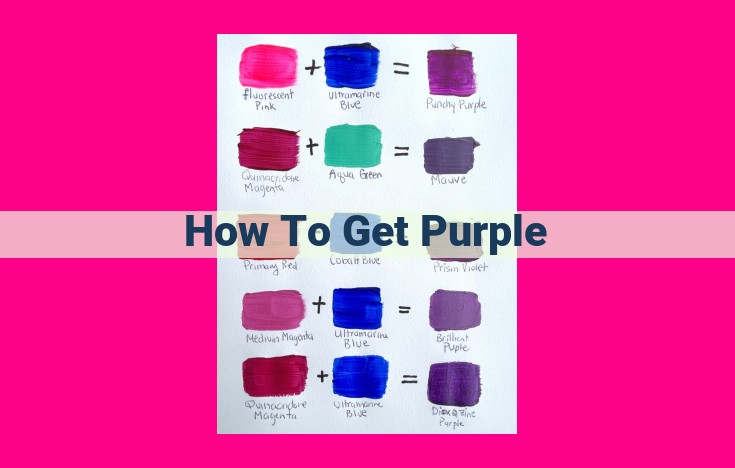Discover The Enchanting World Of Purple: Shades, Pigments, And Natural Sources

To create purple, explore its various shades and hues, including violet, indigo, and plum. Delve into the natural sources of purple pigments, such as purple cabbage and blueberries, to understand how plants produce these pigments. These natural pigments are utilized in various applications, ranging from food coloring to dye production.
Immerse Yourself in the Enchanting World of Purple
Prepare yourself to embark on a journey through the captivating realm of purple, a hue that has long enchanted artists, designers, and all who appreciate its enigmatic charm. From ethereal violets to sumptuous indigos and vibrant magentas, purple presents an array of shades that can evoke emotions ranging from tranquility to passion.
Exploring the Shades and Hues of Purple
The spectrum of purple encompasses a bevy of alluring hues, each with its unique character. Violet, the closest to blue on the color wheel, radiates an air of refinement and mysticism. Indigo, deeper and more intense than violet, evokes a sense of depth and mystery. Magenta stands out as a vibrant blend of red and blue, exuding a captivating boldness. Fuchsia, a vivid pink-purple, embodies exuberance and femininity.
Venturing further into the realm of purple, we encounter orchid, a delicate and captivating shade reminiscent of the exquisite blooms of its namesake flower. Amethyst, a precious gemstone, lends its name to a rich and regal purple hue. Lavender, soft and soothing, evokes images of rolling fields awash in fragrant blossoms. Lilac, a delicate cousin of lavender, exudes a subtle charm.
Moving into deeper territories, we find plum, a luscious and opulent shade reminiscent of ripe autumn fruit. Eggplant, its namesake a deep and enigmatic vegetable, adds a touch of drama and sophistication. Tyrian purple, a vibrant and costly dye prized by ancient civilizations, carries with it an aura of exclusivity and splendor.
Subtle Variations and Historical Significance
The nuances and subtleties within the purple palette are as diverse as the stories they tell. Royal purple and imperial purple have long been associated with power and authority, symbolizing the grandeur of royalty. Mauveine, the first synthetic dye discovered in 1856, revolutionized the fashion industry with its brilliant lilac hue.
Methyl violet and crystal violet serve as valuable laboratory stains, while gentian violet finds application as an antiseptic and antifungal agent. These diverse shades of purple not only delight the eye but also play essential roles in scientific and medical fields.
Unveiling the Vibrant World of Purple Pigments from Nature’s Palette
From the ethereal embrace of violets to the regal splendor of imperial purple, the hue of purple has captivated hearts and imaginations for centuries. Nature, in its infinite artistry, has bestowed upon us an array of natural sources that produce this captivating color.
Red Cabbage: A Culinary Masterpiece
Red cabbage, a culinary delight with its vibrant purple leaves, owes its coloration to anthocyanins. These water-soluble pigments are responsible for the rich hues of red, purple, and blue that adorn many fruits and vegetables. When red cabbage is cooked, its anthocyanins react with acids, resulting in a stunning range of shades from violet to deep burgundy.
Purple Cauliflower: A Cruciferous Gem
Purple cauliflower, a lesser-known but equally vibrant member of the cabbage family, also boasts anthocyanins as the source of its distinctive purple hue. This cruciferous vegetable, when cooked, exudes a sweet, nutty flavor, making it an excellent addition to salads, soups, and stir-fries.
Purple Potatoes: A Culinary Wonder
Purple potatoes, with their skin as dark and enigmatic as an ancient night sky, owe their pigmentation to an even more potent anthocyanin compound called anthocyanin-rich pigments (ARPs). These pigments not only lend紫their distinctive color but also possess antioxidant properties linked to various health benefits.
Purple Carrots: An Underground Rainbow
Purple carrots, a vivid contrast to their ubiquitous orange cousins, produce their unique hue thanks to anthocyanins and beta-carotene. Their sweet and earthy flavor makes them a delightful addition to salads, juices, and roasted vegetable platters.
Purple Beans: A Canopy of Color
Purple beans, whether they be string beans, kidney beans, or runner beans, derive their regal purple hues from anthocyanins. These beans are not only pleasing to the eye but also rich in fiber, protein, and essential vitamins and minerals.
Purple Sea Urchins: A Marine Mystery
Purple sea urchins, with their spiny exteriors, conceal a secret within their shells: a vibrant purple pigment. This pigment, echinochrome, is what gives these marine creatures their distinctive color. Interestingly, the shade and intensity of the purple can vary depending on the sea urchin’s diet and habitat.
Other Natural Sources of Purple Pigments
The world of natural purple pigments extends far beyond the aforementioned sources. Blueberries, raspberries, and blackberries, with their deep blue-purple hues, contain anthocyanins. Artichokes and beets, with their earthy purple shades, owe their color to anthocyanins and betacyanins, respectively.
Applications of Natural Purple Pigments
Throughout history, natural purple pigments have found diverse applications across various fields. They have been used in:
- Culinary Arts: To enhance the visual appeal and nutritional value of dishes.
- Textile Industry: To create vibrant and colorfast fabrics and garments.
- Cosmetics: To add color to lipsticks, blushes, and eyeshadows.
- Medicine: For their potential antioxidant and anti-inflammatory properties.
These natural sources of purple pigments showcase the boundless creativity and beauty of nature. They offer a sustainable and vibrant alternative to synthetic dyes, adding a touch of natural splendor to our lives and reminding us of the interconnectedness of all living things.